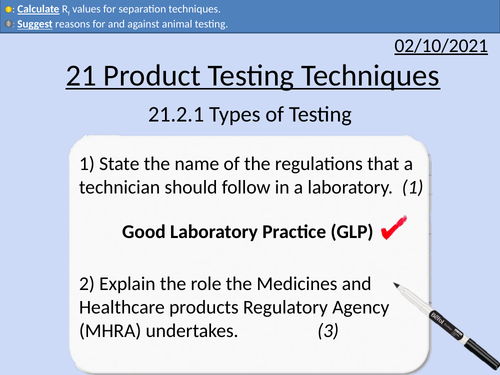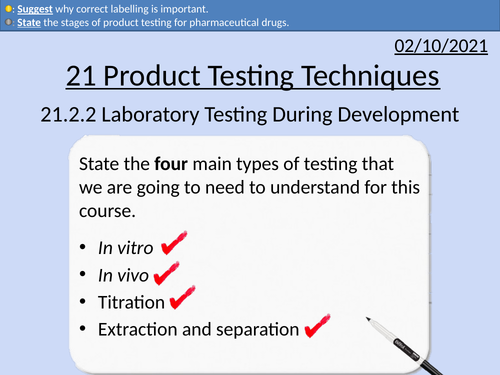496Uploads
163k+Views
70k+Downloads
Biology

GCSE Biology: Mitosis
This presentation covers OCR Gateway Biology 9-1 B2.1.4 Mitosis
This PowerPoint is a whole lessons included with student activities and animated answers.
The cell cycle
DNA replication
Movement of chromosomes
Cytokinesis (cell division)
Growth of daughter cells.

GCSE Biology: Active Transport
This presentation covers OCR Gateway Biology 9-1 B2.1.3 Active Transport
This PowerPoint is a whole lessons included with student activities and animated answers.
Definition of active transport
Key features of active transport
Against concentration gradient.
ATP and respiration
Protein carriers in cell membrane
Active transport in plant cells - root hair cells
Active transport and protein carriers

GCSE Biology: Osmosis
This presentation covers OCR Gateway Biology 9-1 B2.1.2 Osmosis
This PowerPoint is a whole lessons included with student activities and animated answers.
Definition of osmosis.
Explaining water potential and concentration of solution.
How cells change during osmosis - turgid, lysis, crenated, plasmolysed

GCSE Biology: Diffusion
This presentation covers OCR Gateway Biology 9-1 B2.1.1 Diffusion
This PowerPoint is a whole lessons included with student activities and animated answers.
Definition of diffusion from high concentration to lower concentration.
What diffuses in and out of cells.
How the rate of diffusion is affected by distance, surface area, and concentration gradient.
How the human body has adapted to increase the rate of diffusion.

GCSE Biology: Interaction of limiting factors
This presentation covers OCR Gateway Biology 9-1 B1.4.4 Interaction of limiting factors
This PowerPoint is a whole lessons included with student activities and animated answers.
Experimental procedures to investigate how the rate of photosynthesis is affected by:
Light level
Temperature
Carbon dioxide concentration
Inverse square law for relative light intensity

GCSE Biology: Factors Affecting Photosynthesis
This presentation covers OCR Gateway Biology 9-1 B1.4.3 Factors Affecting Photosynthesis
This PowerPoint is a whole lessons included with student activities and animated answers.
Definition for rate of photosynthesis
The rate of photosynthesis affects the rate of biomass
Limiting factors include, light level, carbon dioxide concentration, and temperature.
Graphs for rate of photosynthesis against light level, carbon dioxide concentration, and temperature.
Plotting data graphs.
Exam questions.

GCSE Biology: Photosynthesis
This presentation covers OCR Gateway Biology 9-1 B1.4.1 Photosynthesis
This PowerPoint is a whole lessons included with student activities and animated answers.
Word and symbol equation for photosynthesis.
Carbon dioxide diffuses from the air through the stomata.
Water travels by osmosis through the root hair cells.
Photosynthesis occurs inside the plant’s chloroplast.
Chloroplasts contain a green pigment called chlorophyll.
Photosynthesis is an endothermic reaction.
The two main stages of photosynthesis.
Comparing photosynthesis and aerobic respiration.

GCSE Biology: Anaerobic Respiration
This presentation covers OCR Gateway Biology 9-1 B1.3.3 Anaerobic Respiration
This PowerPoint is a whole lessons included with student activities and animated answers.
Recap of aerobic respiration
Conditions for anaerobic respiration
Word equation for anaerobic respiration in mammals
Lactic acid and its affects.
Oxygen debt
Comparing aerobic and anaerobic respiration in mammals.
Anaerobic respiration in plants - fermentation.
Fermentation word equation and symbol equation.
Exam questions.

GCSE Biology: Carbohydrates, Proteins, and Lipids
This presentation covers OCR Gateway Biology 9-1 B1.3.1 Carbohydrates, Proteins, and Lipids
This PowerPoint is a whole lessons included with student activities and animated answers.
The three main macronutrients - carbohydrates, proteins, and lipids
Names of enzymes - carbohydrase, amylase, protease, lipase
What the macronutrients are broken down into - simple sugars, amino acids, fatty acids and glycerol.
Metabolic rate
Food tests and the positive results

GCSE Biology: Enzyme Reactions
This presentation covers OCR Gateway Biology 9-1 B1.2.4 Enzyme Reactions
This PowerPoint is a whole lessons included with student activities and animated answers.
Enzymes-catalysed reactions
Rate of reaction
Denaturing of enzymes and the active site
Optimum temperature and optimum pH for enzymes
Definition of concentration
Increasing concentration of enzymes and substrates
Saturation of substrates

GCSE Biology: Aerobic Respiration
This presentation covers OCR Gateway Biology 9-1 B1.3.2 Aerobic Respiration
This PowerPoint is a whole lessons included with student activities and animated answers.
Word equation for aerobic respiration
Balanced symbol equation for aerobic respiration
Aerobic respiration is an exothermic reaction
The structure of mitochondria
ATP and its uses
Why blood flow increases to muscles when exercising

GCSE Biology:Transcription and Translation
This presentation covers OCR Gateway Biology 9-1 B1.2.2 Transcription and Translation
This PowerPoint is a whole lessons included with student activities and animated answers.
The role of proteins and AI
Proteins as polymers
Explaining transcription
mRNA and complementary bases
Explaining translation

GCSE Biology: Enzymes
This presentation covers OCR Gateway Biology 9-1 B1.2.3 Enzymes
This PowerPoint is a whole lessons included with student activities and animated answers.
Enzymes are made of protein.
Enzymes are biological catalysts.
Catalysts speed up the rate of reaction without being used up themselves.
Enzymes and the lock and key hypothesis.
Enzymes breaking down and bonding substrates.

GCSE Biology: DNA
This presentation covers OCR Gateway Biology 9-1 B1.2.1 DNA
This PowerPoint is a whole lessons included with student activities and animated answers.
DNA stands for deoxyribonucleic acid.
DNA is found in the nucleus of cells.
DNA is packaged into a thread-like structure called chromosomes.
Humans typically have 46 chromosomes shared from their parents.
Genes are sections of DNA that code for physical characteristics.
The structure of DNA.
DNA is comprised of monomers called nucleotides.
A nucleotide consists of a phosphate group, a sugar (deoxyribose), and an organic base.
There are four organic bases: Adenine, A. Thymine, T. Cytosine, C. Guanine, G.
Hydrogen bonds in DNA.

GCSE Biology: Electron Microscopy
This presentation covers OCR Gateway Biology 9-1 B1.1.4 Electron Microscopy
This PowerPoint is a whole lessons included with student activities and animated answers.
Comparing sizes of different cells
Using standard form
Using SI prefixes (nano, micro, milli, kilo, mega)
Comparing electron microscopes and light microscopes.

GCSE Biology: Animal and Plant Cells
This presentation covers OCR Gateway Biology 9-1 B1.1.1 Animal and Plant Cells
This PowerPoint is a whole lessons included with student activities and animated answers.
Cells are the building blocks of living objects.
Definition of eukaryotic cells
Typical size of eukaryotic cells
Subcellular structure of animal cells
Subcellular structure of plant cells
Organelles and their functions
Revision activities (Look, Cover, Write, Check)
Print out of animal and plant cells

GCSE Biology: Bacterial Cells
This presentation covers OCR Gateway Biology 9-1 B1.1.2 Bacterial Cells
This PowerPoint is a whole lessons included with student activities and animated answers.
Typical size of bacterial cells
Subcellular structure of bacterial cells
Functions of subcellular structure of bacterial cells
Comparing animal, plant, and bacterial cells
Revision activity - flash cards
Print out of bacterial cell

GCSE Biology: Light Microscopy
This presentation covers OCR Gateway Biology 9-1 B1.1.3 Light Microscopy
This PowerPoint is a whole lessons included with student activities and animated answers.
Labeling a light microscope
Defining magnification and resolution.
Explaining why stains are used for light microscope.
Calculating total magnification, objective lens magnification and eyepiece lens magnification.
Calculating actual size, magnification, and magnified size of objects.
Converting from from micrometre (µm) to millimetres (mm)
Rearranging equations

OCR Applied Science: 21.2.1 Types of Testing
OCR Applied Science Level 3 - Module 21: Product Testing Techniques.
This PowerPoint presentation with worked examples and student activities covers: Topic 2.1 of Module 21: Product Testing Techniques.
2.1 Types of testing i.e.:
• in-vitro
• in-vivo
• titration
• extraction and separation

OCR Applied Science: 21.2.2 Testing During Development
OCR Applied Science Level 3 - Module 21: Product Testing Techniques.
This PowerPoint presentation with worked examples and student activities covers: Topic 2.2 of Module 21: Product Testing Techniques.
2.2 Laboratory testing during development i.e.:
• formulation
• production
• quality control and assurance
• after sale monitoring.




















